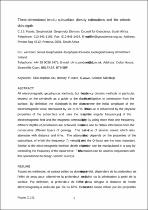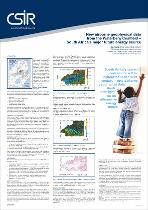 ResearchSpace
ResearchSpace
New airborne geophysical data from the Waterberg coalfield. South Africa's major future energy source
JavaScript is disabled for your browser. Some features of this site may not work without it.
- ResearchSpace
- →
- Research Publications/Outputs
- →
- Conference Publications
- →
- View Item
| dc.contributor.author |
Fourie, CJS

|
|
| dc.contributor.author |
Du Plessis, SJ

|
|
| dc.contributor.author |
Henry, G

|
|
| dc.date.accessioned | 2008-11-14T07:49:35Z | |
| dc.date.available | 2008-11-14T07:49:35Z | |
| dc.date.issued | 2008-11 | |
| dc.identifier.citation | Fourie, CJS, Du Plessis, SJ, and Henry, G. 2008. New airborne geophysical data from the Waterberg coalfield. South Africa's major future energy source. Science real and relevant: 2nd CSIR Biennial Conference, CSIR International Convention Centre Pretoria, 17 & 18 November 2008, pp 9 | en |
| dc.identifier.isbn | 978-0-7988-5573-0 | en |
| dc.identifier.uri | http://hdl.handle.net/10204/2568 | |
| dc.description | Science real and relevant: 2nd CSIR Biennial Conference, CSIR International Convention Centre Pretoria, 17 & 18 November 2008 | en |
| dc.description.abstract | The Waterberg Coalfield in the Limpopo Province of South Africa contains vast resources of coal that will ensure the country's energy security well into the future. The coalfield is situated in the Karoo-age Ellisras Basin and at present hosts only one mining operation. Although the coalfield was discovered in 1920, relatively little drilling has taken place in the Ellisras Basin overall, and the structural complexities are not well defined. Coaltech Research Association commissioned a detailed airborne magnetic and radiometric survey over the Ellisras Basin in 2007 in order to enhance the structural understanding of the area. The CSIR undertook the management of the survey, conducted by the Council for Geoscience, and the interpretation of the data. This paper presents some preliminary findings of the interpretation which is in progress. The overall magnetic susceptibility of the Ellisras Basin is low; however, application of a phase operator revealed subtle anomalies that indicate nonmagnetic structures or pre-Karoo features underneath the Ellisras Basin. Further investigation is required. The radiometric data complemented the magnetic data in defining the basin boundaries, and revealed more features than expected, such as large block faulting. In addition, samples of rocks from several geological units were collected and their physical properties measured to facilitate the geophysical interpretation. This work is ongoing. Integration of the magnetic, radiometric and Landsat interpretation data indicates that many of the linear structures are non-magnetic, and hence difficult to detect. A proposed solution to this problem is an airborne electromagnetic survey over the Ellisras Basin. Although costly, such a survey would greatly benefit future coal resource estimates, and result in improved and more sustainable utilisation of the Waterberg Coalfield | en |
| dc.language.iso | en | en |
| dc.publisher | CSIR | en |
| dc.subject | Waterberg coalfield | en |
| dc.subject | Coal | en |
| dc.subject | Energy | en |
| dc.subject | Geoscience | en |
| dc.subject | Geophysics | en |
| dc.title | New airborne geophysical data from the Waterberg coalfield. South Africa's major future energy source | en |
| dc.type | Conference Presentation | en |
| dc.identifier.apacitation | Fourie, C., Du Plessis, S., & Henry, G. (2008). New airborne geophysical data from the Waterberg coalfield. South Africa's major future energy source. CSIR. http://hdl.handle.net/10204/2568 | en_ZA |
| dc.identifier.chicagocitation | Fourie, CJS, SJ Du Plessis, and G Henry. "New airborne geophysical data from the Waterberg coalfield. South Africa's major future energy source." (2008): http://hdl.handle.net/10204/2568 | en_ZA |
| dc.identifier.vancouvercitation | Fourie C, Du Plessis S, Henry G, New airborne geophysical data from the Waterberg coalfield. South Africa's major future energy source; CSIR; 2008. http://hdl.handle.net/10204/2568 . | en_ZA |
| dc.identifier.ris | TY - Conference Presentation AU - Fourie, CJS AU - Du Plessis, SJ AU - Henry, G AB - The Waterberg Coalfield in the Limpopo Province of South Africa contains vast resources of coal that will ensure the country's energy security well into the future. The coalfield is situated in the Karoo-age Ellisras Basin and at present hosts only one mining operation. Although the coalfield was discovered in 1920, relatively little drilling has taken place in the Ellisras Basin overall, and the structural complexities are not well defined. Coaltech Research Association commissioned a detailed airborne magnetic and radiometric survey over the Ellisras Basin in 2007 in order to enhance the structural understanding of the area. The CSIR undertook the management of the survey, conducted by the Council for Geoscience, and the interpretation of the data. This paper presents some preliminary findings of the interpretation which is in progress. The overall magnetic susceptibility of the Ellisras Basin is low; however, application of a phase operator revealed subtle anomalies that indicate nonmagnetic structures or pre-Karoo features underneath the Ellisras Basin. Further investigation is required. The radiometric data complemented the magnetic data in defining the basin boundaries, and revealed more features than expected, such as large block faulting. In addition, samples of rocks from several geological units were collected and their physical properties measured to facilitate the geophysical interpretation. This work is ongoing. Integration of the magnetic, radiometric and Landsat interpretation data indicates that many of the linear structures are non-magnetic, and hence difficult to detect. A proposed solution to this problem is an airborne electromagnetic survey over the Ellisras Basin. Although costly, such a survey would greatly benefit future coal resource estimates, and result in improved and more sustainable utilisation of the Waterberg Coalfield DA - 2008-11 DB - ResearchSpace DP - CSIR KW - Waterberg coalfield KW - Coal KW - Energy KW - Geoscience KW - Geophysics LK - https://researchspace.csir.co.za PY - 2008 SM - 978-0-7988-5573-0 T1 - New airborne geophysical data from the Waterberg coalfield. South Africa's major future energy source TI - New airborne geophysical data from the Waterberg coalfield. South Africa's major future energy source UR - http://hdl.handle.net/10204/2568 ER - | en_ZA |






